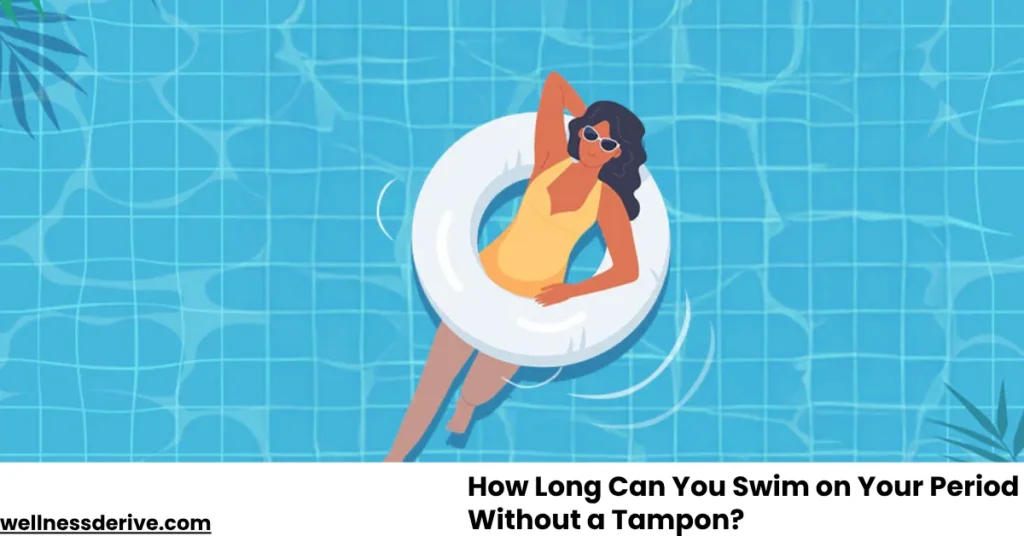Swimming during your period can feel intimidating, especially if you prefer not to use tampons. The question many menstruating individuals ask is: How long can you swim on your period without a tampon? This comprehensive guide explores that in depth—along with safe alternatives, hygiene tips, and practical advice to help you feel confident in the water.
Understanding Periods and Swimming
Before diving in, it helps to understand how your menstrual flow reacts to being in water. Many believe that their period stops entirely when submerged. While it may seem like your period stops in water, it doesn’t. The water pressure temporarily slows or prevents the flow, but it resumes once you leave the pool.
Is It Safe to Swim on Your Period Without a Tampon?
One of the most common questions is, is it safe to swim on your period without a tampon? The short answer is yes, with the right precautions. Swimming without a tampon is safe for your health and generally acceptable in pools, as long as you manage your menstrual flow effectively. Contrary to a popular myth, your period doesn’t stop in water without a tampon. Water pressure may temporarily slow the flow, but it doesn’t halt it entirely, so you’ll need a solution to prevent leaks and maintain hygiene.
Swimming pools are treated with chlorine, which kills bacteria, reducing the risk of contamination from menstrual blood. However, for hygiene and courtesy, it’s best to use a menstrual product or alternative to manage your flow. For those with a light flow or at the beginning/end of their period, swimming without any product might be feasible, but it’s not recommended for heavier flows due to potential leaks.
Addressing the Myth: Does Your Period Stop in Water Without a Tampon?
A common misconception is that your period stops in water due to water pressure. While the pressure of water can temporarily reduce the appearance of menstrual flow, it doesn’t stop it. Once you exit the water, any blood that wasn’t released may flow out, which could lead to visible leaks. This is why relying on water pressure alone isn’t a reliable strategy for swimming on your period no tampon. Instead, consider tampon alternatives or period swimwear to stay confident and leak-free.
How Long Is It Safe to Swim Without a Tampon?
If you’re asking how long can you swim on your period without a tampon, the answer largely depends on your flow. For light flow days, you may be able to swim comfortably for 30 minutes to an hour without noticeable leakage. However, heavy flow days require more caution.
- Light Flow: 30–60 minutes (with minimal risk)
- Moderate Flow: Limit time to 15–30 minutes without protection
- Heavy Flow: Not recommended without some form of menstrual protection
When Tampons Aren’t an Option
Not everyone feels comfortable using tampons due to age, health concerns, or personal preference. The Mayo Clinic warns that improper tampon use may lead to irritation or in rare cases, toxic shock syndrome (TSS), underscoring the importance of using alternatives if you’re uncomfortable with tampons. So, do you have to wear a tampon in the pool? The short answer is no—but alternatives should be considered to maintain hygiene and comfort.
If your period is too light for a tampon or if you simply choose not to use one, you can still enjoy swimming with the right precautions.
Tampon Alternatives for Swimming
If tampons aren’t your preference—whether due to comfort, environmental concerns, or a light flow—there are several effective alternatives for swimming. Let’s explore the best options for tampon alternatives for swimming and how they work.
Swimming with a Menstrual Cup
A menstrual cup is a fantastic option for swimming with a menstrual cup. These reusable, bell-shaped silicone or rubber devices collect menstrual blood rather than absorb it, making them ideal for water activities. Menstrual cups can hold more fluid than tampons, offering up to 12 hours of protection, depending on your flow. They create a suction seal, preventing leaks, which makes them perfect for swimming. According to the Mayo Clinic, menstrual cups can safely hold more fluid than tampons and are suitable for up to 12 hours of wear, making them ideal for extended water activities.
To use a menstrual cup for swimming:
- Insert the cup before entering the water, ensuring it’s properly positioned.
- Check the seal by gently tugging the stem to confirm it’s secure.
- Empty and rinse the cup after swimming, especially if you’re at a waterpark for an extended period.
Menstrual cups are eco-friendly, cost-effective, and suitable for all flow types, including period too light for tampon swimming. Brands like DivaCup, Saalt, or Lena are popular choices.
Period Swimwear for Light Flow
For those with a lighter flow, period swimwear for light flow is a game-changer. Period swimwear looks like regular swimsuits but has a built-in absorbent layer that holds light menstrual flow without leaking. These swimsuits are designed to be worn alone or with a menstrual cup for added protection on heavier days. Brands like Knix, Ruby Love, and Modibodi offer stylish, leak-proof options that blend seamlessly with your swimwear collection.
Benefits of period swimwear:
- Discreet and comfortable, with no need for additional products.
- Ideal for teens or those who find tampons or cups uncomfortable.
- Reusable and machine-washable, making them eco-friendly.
If your flow is too light for a tampon, period swimwear is a practical solution for swimming while on period no tampon.
Why Pads Aren’t Suitable for Swimming
You might wonder, can I wear pads while swimming? Unfortunately, pads are not designed for water activities. They absorb water, becoming bulky and ineffective, and may not stay in place under a swimsuit. For this reason, pads are not a viable option for swimming. Instead, opt for menstrual cups or period swimwear for reliable protection.
DIY Tampon for Swimming: A Word of Caution
Some online sources suggest creating a DIY tampon for swimming using materials like sponges or cotton. However, this is not recommended. DIY solutions may not be sterile, increasing the risk of infection, and they lack the reliability of commercial products. If you’re in a pinch, consider period swimwear or a menstrual cup instead, as these are safer and designed specifically for menstrual management.
Tips for Managing Periods in Water
Want to know how to swim on your period without a tampon and still feel secure? Here are some helpful tips:
1. Swim During Light Flow Days
- Time your swim around your period cycle
- Day 1 and 2 are often the heaviest; plan accordingly
2. Empty Your Cup or Change Protection Before Swimming
- Ensures maximum effectiveness and comfort
3. Wear Dark-Colored Swimwear
- Helps conceal any accidental spotting
4. Use a Towel Wrap When Out of the Pool
- Minimize staining by wrapping up quickly after exiting the water
5. Carry Extra Supplies
- Pack backup underwear, swimwear, and menstrual products
Hygiene and Safety Considerations
Menstrual hygiene is just as important in the water as it is on land. Neglecting it can lead to discomfort or health issues.
Best Practices:
- Shower immediately after swimming to wash away chlorine and residual blood. The CDC recommends showering before and after swimming and highlights the importance of maintaining pool hygiene to prevent the spread of bodily fluids.
- Change your menstrual product right after swimming to avoid bacterial growth
- Avoid swimming in natural bodies of water like lakes or oceans during heavy flow to minimize infection risk
Natural Ways to Manage Periods in Water
If you prefer natural ways to manage periods in water, there are lifestyle adjustments that can help reduce flow or symptoms, though they won’t replace menstrual products entirely.
Diet and Hydration
Certain foods and drinks can influence your menstrual flow:
- Iron-Rich Foods: Foods like spinach or lean meats can help replenish iron lost during your period, reducing fatigue.
- Anti-Inflammatory Foods: Ginger, turmeric, or omega-3-rich foods (e.g., salmon) may reduce cramps and inflammation.
- Hydration: Drinking plenty of water can help manage bloating and keep you comfortable while swimming.
Exercise and Stress Management
Regular exercise, including swimming, can reduce menstrual cramps by improving blood flow. Practice stress-relief techniques like yoga or meditation before your swim to ease tension and promote a lighter flow.
Herbal Remedies
Some herbal teas, such as chamomile or raspberry leaf, are believed to ease menstrual symptoms. Consult a healthcare provider before trying herbal remedies, as they may not be suitable for everyone.
Do You Have to Wear a Tampon in the Pool?
A common question is, do you have to wear a tampon in the pool? The answer is no—tampons are not mandatory. Pool regulations typically focus on general hygiene, not specific menstrual products. However, to prevent leaks and maintain comfort, using a menstrual cup, period swimwear, or another alternative is recommended, especially for heavier flows.
Myths vs. Facts: Periods in Water
Myth: Your period completely stops in water
Fact: It slows but resumes immediately when you leave
Myth: You can’t swim without a tampon
Fact: With the right planning, you can
Myth: Swimming on your period is unhygienic
Fact: It’s safe when proper menstrual hygiene is maintained
Frequently Asked Questions
Final Thoughts: Embrace Confidence in the Water
Swimming on your period without a tampon is not only possible—it’s safe and manageable. By understanding your body, flow, and using the right products, you can enjoy water activities without worry.
Remember, whether it’s a relaxing swim, a day at the beach, or a waterpark visit, your period doesn’t have to hold you back.
Be informed. Be prepared. Be confident.
Disclaimer: The content on Wellness Derive is for informational purposes only and not a substitute for professional medical advice, diagnosis, or treatment. Always consult a healthcare provider for medical concerns.



